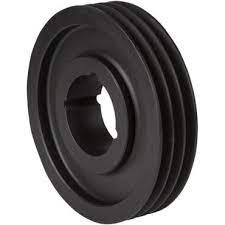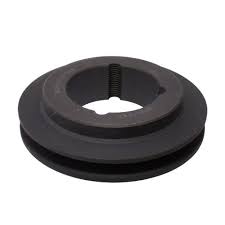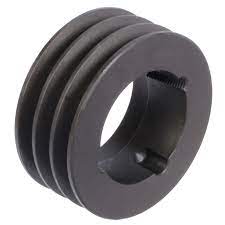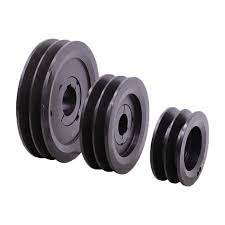Product Description
Timing pulley price hi ace tensioner belt hob cutter cast iron manufacture best sale transmission machine parts SPA/06 european standard timing pulley
In power transmission, belts are flexible loops of material that can link 2 rotating shafts mechanically and transmit power between them. Belts are also the primary component in belt drives, where 1 or more continuous belts are fitted over 2 pulleys at 2 shafts and rotary motion is transferred from the driving pulley to the driven pulley.
As compared to chain drives and gear drives, belt drives run quietly and smoothly and do not need lubrication. Maintenance is also comparatively convenient, and the driven shaft speed can be easily altered by changing pulley sizes.
The most common types of belts are V-belts and timing belts. V-belts are the most common type of belt today, and as their name suggests, their cross-sectional shape comes in the form of a “V”. Generally endless, the “V” cross-sections of these belts lodge in the mating grooves of their corresponding V-belt pulleys, preventing slipping due to under-10sioning. In general, V-belts require less width and tension compared to flat belts.
Timing belts are toothed belts that enable positive drive. They have rows of interlocking teeth that fit securely with a toothed pulley to avoid slipping. Timing belts require less tension than other belts, have no slippage, and do not require lubrication, however their power capacity is lower than V-belts and chains. They are frequently used in camshafts of automobiles and crankshafts.
/* January 22, 2571 19:08:37 */!function(){function s(e,r){var a,o={};try{e&&e.split(“,”).forEach(function(e,t){e&&(a=e.match(/(.*?):(.*)$/))&&1
| Certification: | CE, ISO |
|---|---|
| Pulley Sizes: | SPA/06 |
| Manufacturing Process: | Casting |
| Material: | Iron |
| Application: | Chemical Industry, Grain Transport, Mining Transport, Power Plant |
| Transport Package: | Wooden Case |
| Samples: |
US$ 9999/Piece
1 Piece(Min.Order) | |
|---|

How do you select the right spa pulley for a specific spa model and purpose?
Selecting the right spa pulley for a specific spa model and purpose involves considering several factors. Here’s a detailed explanation of the steps involved in choosing the appropriate spa pulley:
1. Identify the Spa Model:
Begin by identifying the specific make and model of the spa for which you need the pulley. Different spa models may have varying requirements in terms of power transmission, belt type, and pulley configuration. Consult the spa manufacturer’s documentation, specifications, or contact their customer support to gather information about the recommended pulley specifications for your spa model.
2. Determine the Purpose:
Next, determine the purpose of the pulley within the spa system. Are you selecting a pulley for a pump, blower, control system, filtration system, or another component? Understanding the purpose will help you narrow down the specific requirements and characteristics needed for the pulley.
3. Consider Power Requirements:
Consider the power requirements of the component the pulley will drive. This includes factors such as the motor power rating, desired speed, and torque. Ensure that the pulley you choose is capable of handling the power demands of the specific spa equipment.
4. Evaluate Belt Type and Size:
Determine the type and size of the belt that will be used with the pulley. Different spa systems may utilize V-belts, flat belts, timing belts, or other belt types. Verify the belt type specified by the spa manufacturer and ensure that the pulley is designed to work with that particular belt type. Additionally, consider the appropriate belt size based on factors such as the pulley diameter, desired speed ratio, and power transmission requirements.
5. Assess Pulley Material and Construction:
Consider the material and construction of the pulley. Common materials include stainless steel, aluminum, brass, or various types of plastics or polymers. The choice of material depends on factors such as durability, corrosion resistance, and compatibility with the spa environment. Verify if there are any specific material recommendations from the spa manufacturer and select a pulley that meets those requirements.
6. Verify Pulley Configuration:
Verify the specific configuration of the pulley, such as the number of grooves or teeth, if applicable. This should match the number of belts or the desired timing of the system. Ensure that the pulley configuration aligns with the recommended specifications provided by the spa manufacturer.
7. Seek Expert Advice if Needed:
If you are unsure about any specific details or have difficulty finding the right pulley for your spa model and purpose, it is advisable to seek expert advice. Contact the spa manufacturer, a spa equipment supplier, or consult with a knowledgeable professional who can provide guidance and assistance in selecting the appropriate pulley.
In summary, selecting the right spa pulley for a specific spa model and purpose involves identifying the spa model, determining the purpose of the pulley, considering power requirements, evaluating belt type and size, assessing pulley material and construction, verifying pulley configuration, and seeking expert advice if needed. By following these steps and considering the recommended specifications, you can ensure that the chosen pulley is suitable for your spa equipment, enabling efficient power transmission and reliable operation.

What is the significance of proper alignment and tensioning in spa pulley systems?
Proper alignment and tensioning are crucial for the optimal performance and longevity of spa pulley systems. Here’s a detailed explanation of their significance:
1. Efficient Power Transmission:
Proper alignment and tensioning ensure efficient power transmission within the spa pulley system. When the pulleys are correctly aligned, the belt or cable connecting them maintains proper engagement, maximizing power transfer from the motor to the driven components such as pumps, blowers, or jets. Efficient power transmission results in optimal performance, ensuring that the spa operates at its intended capacity and delivers the desired water flow, pressure, and air delivery.
2. Reduced Wear and Friction:
Improper alignment or tensioning can cause excessive wear and friction in the spa pulley system. Misalignment can lead to uneven loading on the pulleys and belts or cables, causing accelerated wear and fatigue. Inadequate tensioning can result in slippage, which generates heat and increases friction between the pulleys and the belt or cable. Proper alignment and tensioning help distribute the load evenly, reducing wear, heat generation, and friction. This prolongs the lifespan of the pulleys and associated components, minimizing the need for premature replacements.
3. Noise Reduction:
Misaligned or improperly tensioned spa pulleys can produce noise during operation. Misalignment may cause the pulleys to run off-center, resulting in vibrations and noise. Insufficient tensioning can lead to belt or cable slippage, which generates squealing or screeching sounds. Proper alignment and tensioning help eliminate or minimize these noise issues, ensuring a quieter and more enjoyable spa experience for users.
4. Prevented Belt or Cable Failure:
Correct alignment and tensioning prevent belt or cable failure in spa pulley systems. Misalignment or excessive tension can cause belts or cables to stretch, fray, or wear out prematurely. Over time, this can lead to belt or cable failure, resulting in unexpected downtime and costly repairs. By maintaining proper alignment and tensioning, the risk of belt or cable failure is significantly reduced, promoting reliable operation and avoiding disruptions in spa performance.
5. Enhanced Safety:
Properly aligned and tensioned spa pulley systems contribute to enhanced safety for spa users and technicians. Misaligned pulleys or improperly tensioned belts or cables can pose safety risks. Misalignment may cause unexpected movement or dislodging of components, leading to potential accidents or injuries. Excessive tensioning can strain the system, increasing the risk of component failure or breakage. By ensuring proper alignment and tensioning, the risk of safety hazards is minimized, providing a safe and secure spa environment.
6. Optimal Energy Efficiency:
A properly aligned and tensioned spa pulley system promotes optimal energy efficiency. Misalignment or inadequate tensioning can result in energy losses due to increased friction, slippage, or unnecessary strain on the system. Proper alignment and tensioning minimize these energy losses, allowing the spa to operate more efficiently and reducing energy consumption. This not only saves on operating costs but also supports sustainable and eco-friendly spa practices.
In summary, proper alignment and tensioning are critical for the optimal performance, reliability, safety, and energy efficiency of spa pulley systems. They ensure efficient power transmission, reduce wear and friction, minimize noise, prevent belt or cable failure, enhance safety, and promote optimal energy usage. Regular inspection, adjustment, and maintenance of alignment and tensioning are essential to maximize the benefits and lifespan of the spa pulley system.

How do spa pulleys contribute to the operation of water circulation and jets?
Spa pulleys play a crucial role in the operation of water circulation and jets within a spa or hot tub system. Here’s a detailed explanation of how spa pulleys contribute to the operation of water circulation and jets:
1. Water Circulation:
In spa and hot tub systems, water circulation is essential for maintaining water quality, distributing heat evenly, and ensuring effective filtration. Spa pulleys are commonly used to connect the motor or drive source to the pump impeller. As the motor rotates, it drives the spa pulley, which then transfers rotational power to the pump impeller. The impeller creates a suction force that draws water into the pump and then pushes it through the filtration system and jets, facilitating water circulation throughout the spa or hot tub.
2. Jet Operation:
Jets in a spa or hot tub system are responsible for creating therapeutic water flow and pressure. Spa pulleys play a significant role in powering and controlling the jets. The motor or drive source is connected to the pump impeller via the spa pulley. As the impeller spins, it pressurizes the water, which is then directed through the jet nozzles. The spa pulley ensures that the impeller receives sufficient rotational power to generate the desired water flow and pressure, providing a soothing and invigorating hydrotherapy experience.
By transferring rotational power from the motor to the pump impeller, spa pulleys enable efficient water circulation and jet operation in the following ways:
Belt Engagement: The grooved or toothed surface of the spa pulley securely engages the belt, such as a V-belt or timing belt, preventing slippage. This ensures that the rotational power from the motor is effectively transferred to the pump impeller, promoting consistent water circulation and jet performance.
Power Transmission: The spa pulley acts as a mechanical link between the motor or drive source and the pump impeller. As the motor rotates, the pulley rotates as well, transmitting rotational power to the impeller. This power transmission drives the impeller’s spinning motion, creating the necessary water flow and pressure for water circulation and jet operation.
Pulley Ratio: In some cases, spa pulleys are designed with specific ratios to achieve desired speed or torque outputs. By selecting pulleys with the appropriate ratio, the rotational speed or torque can be adjusted to meet specific water circulation and jet performance requirements. This allows for customization and optimization of the system’s water movement and therapeutic effects.
Overall, spa pulleys are integral components that contribute to the smooth operation of water circulation and jets in spa and hot tub systems. They ensure the efficient transfer of rotational power from the motor to the pump impeller, facilitating proper water flow, pressure, and distribution throughout the system, as well as delivering an enjoyable hydrotherapy experience.


editor by CX
2024-03-28




.jpg)

